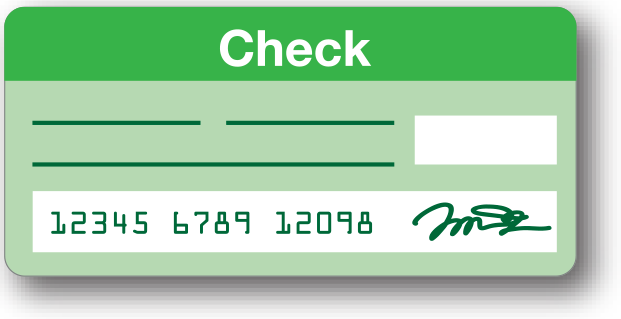How do you pay your bills? How do you pay for dinner? a movie? new shoes? ice cream?
There are a number of ways to pay for items you purchase or to pay the bills you have monthly (as adults). For my students to understand all of the advantages and disadvantages of the different payment methods, I used a lesson from SmarterTexas.org called "How Will I Pay?" In this activity, students are introduced to six methods of payment (we only made it through the first 4 today):
- cash
- check
- debit card
- money transfer (online banking/PayPal)
- automatic payments
- credit cards
In discussing each method we discovered:
I began with CASH because this is the form of payment most 5th graders use.
I asked the kids to pretend that cash was their only possible form of payment at this time. We talked about three statements and decided if these were a disadvantage or advantage to us:
- I can carry cash in my pocket or wallet.
- I can only spend what I have on me.
- Cash is easy to lose or have stolen.
After much discussion, we decided the first two had some advantages AND disadvantages. However, we all agreed that having your money stolen, or losing it, was ALWAYS a disadvantage.
| Add caption |
Next, we moved on to CHECKS:
Again, I asked the kids to limit their thinking to cash and checks. I explained that they would need to open a checking account once they had a job and received a paycheck. We discussed purchasing checks and that they are basically a permission slip to our bank to give money to the person named on the check. We also discussed that checks hold enough personal information to allow a thief to use the information to steal your identity, and stolen checks can be used to purchase items from stores or online as ID is not usually required when a check is written.
We also discussed what can happen if you "bounce" a check (first explaining that they do not actually bounce)! They were appalled when they found out that every check that you "bounce" can cost you an additional $25 -$30! (How can you pay that when you didn't have any money to begin with?!?!) Which led to very good discussion about keeping track of when and how you spend money.
This time, we had six statements to evaluate and place:
- If you write a check for more than the amount in the checking account, you will pay a fee.
- If your checks are lost or stolen someone might try to write checks on the account.
- Some stores do not accept checks.
- If a payment has to be mailed, sending a check is safer than sending cash.
- A check may be used to prove that a payment was made.
- Most people who write checks keep track of their spending since the check register is in the check book.
Next, we moved to DEBIT CARDS.
When discussing debit cards, I explained that this card is attached directly to your checking account. Every time you use the card, money comes out of the account. You must keep track of the money spent so that you do not have "insufficient funds".... you can't have the items you want to purchase, you don't have enough money.
We talked about how a debit protects you with a PIN at an ATM, but that a PIN is not needed at a store (if you choose "credit") or online, so it isn't as safe as you might think! Also, using an ATM that is not part of your bank network can cost you an additional fee.
My daughter had her wallet stolen last weekend, so I had all kinds of good examples to share with the classes! I explained how she immediately contacted the bank to shut down the debit card so that money could not be siphoned from her accounts.
The statements to evaluate were:
- PIN is a secret number code that only the owner of the account and the bank knows.
- If you don't keep track of your spending, you run the risk of spending more than what is in the account and you may have to pay a fee.
- Debit cards are easy to carry and use.
- If your debit card is stolen or lost, report it to the bank immediately. They will cancel the card and issue a new card.
- Some financial institutions charge fees for using the debit card.
Our final topic today was MONEY TRANSFER (like online banking or PayPal).
I explained that money transfers, like debit cards, take money directly from your account and transfer the money into another account.
This is a convenient way to pay monthly bills, or to pay for items online as you don't have to put in a debit or credit number and run the risk of having your cards compromised. The statements that we evaluated were:
- By paying bills with a transfer you do not need checks or postage.
- Some financial institutions charge fees for money transfers.
- By using a money transfer when shopping online, you do not need to give a debit or credit card number.
- Fast way to send money, convenient.
- You need to have enough money in your bank account.
- Easy to forget to record how much was spent and you run the risk of spending more than is in the account.
We will finish our discussion on methods of payment tomorrow.









No comments:
Post a Comment